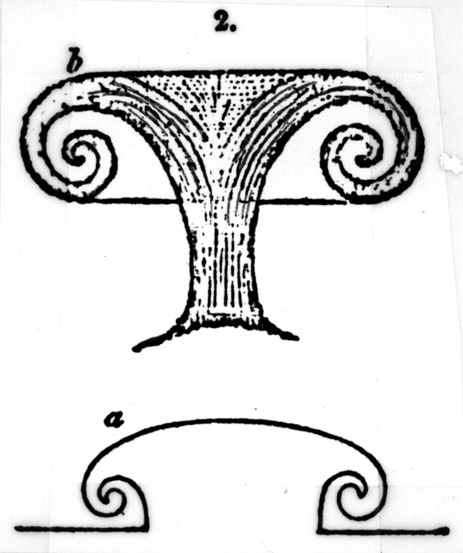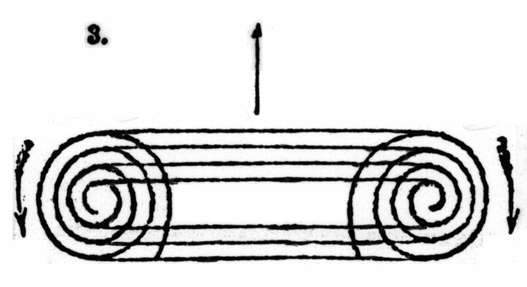"An attempt has recently been made, based on abstruse mathematical calculations, to carry our knowledge of the constitution of matter one step further back, and identify atoms with ether. This is attempted by the vortex theory of Helmholz, Sir W. Thomson, and Professor Tait. It is singular how some of the ultimate facts discovered by the refinements of science correspond with some of the most trivial amusements. Thus the blowing of soap-bubbles gives the best clue to the movement of waves of light, and through them to the dimensions of molecules and atoms; and the collision of billiard-balls, knocked about at random, to the movements of those minute bodies, and the kinetic theory of gases. In the case of the vortex theory the idea is given by the rings of smoke which certain adroit smokers amuse themselves by puffing into the air. These rings float for a considerable time, retaining their circular form, and showing their elasticity by oscillating about it and returning to it if their form is altered, and by rebounding and vibrating energetically, just as two solid bodies would do, if two rings come into collision. If we try to cut them in two, they recede before the knife, or bend around it, returning, when the external force is removed, to their original form without the loss of a single particle, and preserving their own individuality through every change of form and of velocity. This persistance of form they owe to the fact that their particles are revolving in small circles at right angles to the axis or circumference of the larger circle which forms the ring; motion thus giving them stability, very much as in the familiar instance of the bicycle. They burst at last because they are formed and rotate in the air, which is a resisting medium; but mathematical calculation shows that in a perfect fluid free from all friction these vortex rings would be indivisible and indestructible: in other words, they would be atoms.

Figures 3.31 - Vortex orthogonal and self-contained motions, structure. (click to enlarge)

Figures 3.32 - Vortex orthogonal and self-contained motions, cross-section. (click to enlarge)
See Also
"The vortex theory assumes, therefore, that the universe consists of one uniform primary substance, a fluid which fills all Space, and that what we call matter consists of portions of this fluid which have become animated with vortex motion. The innumerable atoms which form molecules, and through molecules all the diversified forms of matter of the material universe, are therefore simply so many vortex rings, each perfectly limited, distinct, and indestructible, both as to its form, mass, and mode of motion. They cannot change or disappear, nor can they be formed spontaneously. Those of the same kind are constituted after the same fashion, and therefore are endowed with the same properties.
"The theory is a plausible one, and the reputation of its authors must command for it respectful consideration; but it is as yet a long way from being an established theory which can be accepted as a true representation of facts. In the first place it is based solely on mathematical theory, and not, as in the case of atoms and light-waves, upon actual facts of weight and measurement tested by experiment, and to which mathematical reasoning affords only an aid and supplement. No one has proved the existence of such a medium or of such vortex rings, much less weighed or measured them.
"Moreover the theory is open to some very obvious objections. How can aggregations of imponderable matter acquire weight, and become subject to the law of gravity, which, as we have seen, is one of the essential and permanent qualities of atoms? If a cubic millionth of a millimeter of ether formed into a big vortex ring of, say, an atom of mercury, has a weight equal to 200 times that of an atom of hydrogen, which itself has a definite weight, why has it no weight in its original form? And if it had weight, however small, how could the enormous mass of ether filling all Space produce no perceptible effect on bodies, even of attenuated cometic vapor, revolving through it with immense velocities? Again, how could these innumerable vortex rings be formed out of the ether without disturbing the uniformity and continuity of the medium, which are essential for the propagation of the light-waves through it? And how could the motions requisite to form the vortex rings be impressed on the them de novo consistently with the principle of the conservation of energy? Energy can no more be created out of nothing than matter, by any process known in nature or conceivable by the human intellect; and to assume it is simply a more refined manner of falling back on the supernatural, which is itself only a more refined manner of saying that we know nothing.
"For the present, therefore, we must be content with atoms and ether as the ultimate terms of our knowledge of the material or quasi-material components of the universe." Laing, Stephen; A Modern Zoroastrian; Chapman and Hall, London, 1891
